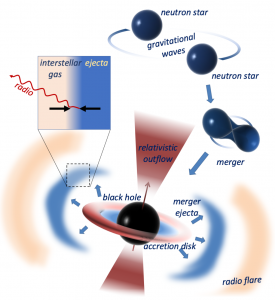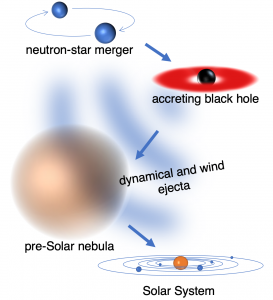Black hole mergers in AGN disks
The Group studies the fate of stellar-mass black holes in Active Galactic Nuclei (AGNs). Stellar remnants are expected to migrate towards supermassive black holes in galactic nuclei due to dynamical friction. In the case of the Milky Way, a steep density cusp of about 20,000 black holes is present in the central parsec. Much heavier, so called intermediate mass-BHs (M ≫ 10 M⊙) may have also migrated to the center or have formed there. The Group investigates the expected properties of black hole mergers in AGN disks using numerical methods, and observationally probes this black hole population using gravitational waves and the observations of host galaxy candidates. We additionally study the possibility of multi-messenger emission from AGN-assisted mergers.
Nearby neutron star mergers
The Bartos Group carries out multi-messenger searches targeting nearby neutron star mergers. Neutron star merger GW170817 was discovered through multiple cosmic messengers at a distance an order of magnitude closer than previously known events identified via gamma-ray bursts. The properties of GW170817 show that this is due to observational selection effects: nearby events are most likely observed off-axis, making standard follow-up observing strategies inadequate. The Group carries out observations with the Karl G. Jansky Very Large Array to identify long-term radio emission from possible nearby neutron star mergers, and works on strategies using high energy emission detected by the IceCube neutrino observatory and other facilities to identify and characterize nearby events.
Neutron star mergers & the Solar System
The Bartos Group searches for nearby neutron star mergers that impacted Earth. Heavy elements produced exclusively through rapid neutron capture (the “r-process”), such as gold and uranium, likely originate from neutrons star mergers. As these mergers are rare in the Milky Way, short-lived radioactive elements found on Earth can be used to trace back their origin to a few, or even a single, nearby neutron star merger that deposited substantial quantities of matter on Earth. The Group uses the measured abundances of short lived elements, as well as numerical simulations, to understand the properties of neutron star mergers and could identify nearby ones.


